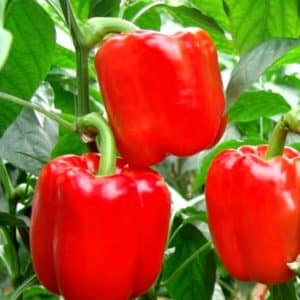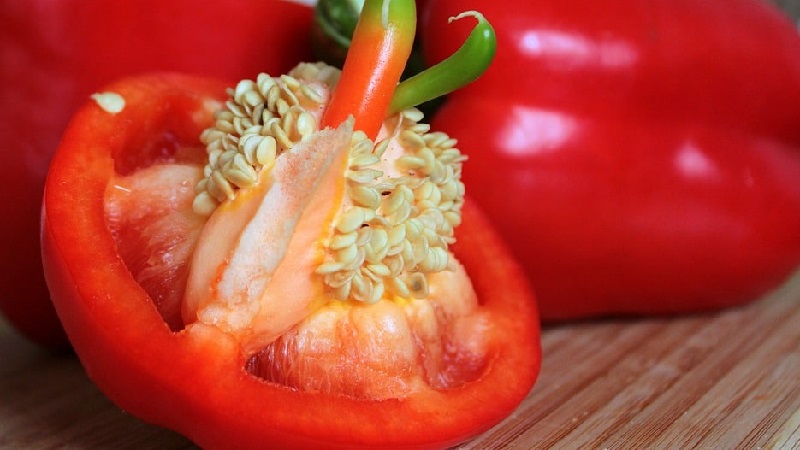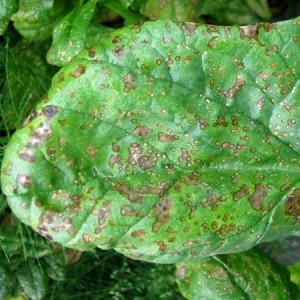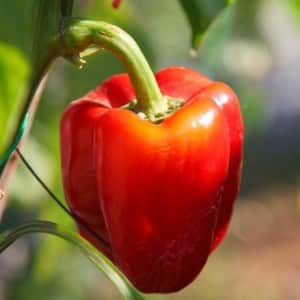Sweet and juicy pepper variety “Tolstyachok” for greenhouses and open ground
The bright multi-colored fruits of bell peppers during the harvest period are a real decoration of any summer cottage. Healthy paprika looks appetizing on the table in salads, hot dishes, and canned food. Only laudatory reviews are written about pepper as a storehouse of vitamins.
The Tolstyachok sweet pepper variety fully corresponds to its name - the bright red fruits have thick and juicy walls. Both experienced and novice gardeners reap a significant harvest by following simple rules for growing and caring for crops.
Fatty - what kind of pepper is this?
The Tolstyachok variety is a hybrid that is the result of combining other varieties. As befits a hybrid, Fatty has a strong immunity to diseases, is unpretentious in care and tolerates sudden temperature changes well.

Description of the variety
- The variety is mid-season, the harvest is harvested 115 days after planting.
- They are grown both in greenhouses and in open ground.
- The bushes are small, about 45-55 cm in height.
- The plant is semi-spreading and has a strong stem.
- The leaves are slightly wavy, bright green, medium in size.
For the fastest and healthiest development, gardeners recommend forming a bush. Otherwise, caring for Tolstyachok sweet peppers does not require special skills.
Fruit characteristics and yield
The pepper has a slightly rounded, prism-shaped shape. The average weight of one fruit is about 150 g, in favorable climatic conditions it can reach 200 g. Length about 10 cm, diameter 7 cm.
The surface is smooth and glossy, bright red in color. The pulp is thick and has a pronounced sweet taste. Thanks to its dense peel, the Tolstyachok variety is perfectly stored and transported. Yield indicators are stable, from 1 sq. m, gardeners collect about 4 kg of healthy vegetables.
Interesting! Central America is considered to be the birthplace of pepper. It was in its areas that archaeologists found the first mentions of the vegetable. People have been using peppers as food since 6,000 BC. Later, breeders from Bulgaria managed to develop sweet varieties, which received the well-known name “Bulgarian”.
Preparation for cultivation
 Growing sweet peppers is an easy process. Prepared soil will be the key to a good harvest. Future beds must be clean, disinfected and filled with plant nutrients and elements.
Growing sweet peppers is an easy process. Prepared soil will be the key to a good harvest. Future beds must be clean, disinfected and filled with plant nutrients and elements.
In the fall, they are dug up on the handle of a shovel, removing all debris and weeds. Then ash and compost are scattered to reduce the acidity of the soil, make it more useful, and destroy pathogenic elements.
In the spring, the beds are dug up again and Nitrofoska fertilizer is applied.. To make the soil looser and lighter, it is sprinkled with sawdust or river sand, which serve as an excellent natural leavening agent. To disinfect the beds, water them with a manganese solution. This will protect the plants from infectious and viral diseases.
Seed preparation:
- Place in the oven for 3 hours at 40°C.
- Germinate the material by placing it in a damp cloth bag and storing it in a warm place.
- After 5 days, the seeds will give the first sprouts, after which hardening is carried out: put the seed material in the freezer for 1 hour.In the future, carry out the procedure for another 4-5 days, each time increasing the time the seeds are in the freezer by 15-20 minutes. Hardening helps plants quickly adapt to the climatic conditions of the growing region.
It can be useful:
Why peppers don't bloom in a greenhouse
Growing seedlings
Sowing seeds for seedlings is carried out 2 months before planting peppers in open ground.. Only healthy seeds are used, small or damaged specimens are removed. Before sowing, be sure to soak the seeds in a solution of the drug “Fitosporin-M” or “Maxim”. They also prepare a container for seedlings; most often, gardeners use plastic cassettes with trays or plastic cups. They are inexpensive and easy to use.
Important! Pay attention to the soil for seedlings. It is better to use disinfected soil from the garden, adding washed sand to it (in a ratio of 6:1). Gardeners also add peat or humus to the composition. If you don’t have the time or desire to prepare the soil yourself, buy ready-made “Universal” soil in the store.
- Pour the prepared mixture into the container, make small holes 1-2 cm deep in it. The distance between the holes is at least 5 cm.
- Place the sprouted seeds in the grooves, sprinkle soil on top and water generously.
- Cover the seedlings with film and place them on the sunniest windowsill.
- Remove the film after the first leaves appear.
- Water the seeds generously with warm filtered water. Next time moisturize in a week. Excess moisture will harm the seedlings.
When growing pepper seedlings on a windowsill, avoid drafts. Water every 5 days at the root to prevent moisture from getting on the leaves. Water should be at room temperature, as cold water increases the risk of developing dangerous microbes.
The Fatty variety loves organic fertilizers, such as nettle-based solution, wood ash, liquid mullein. For faster development of sprouts, the growth stimulator “Zircon” is added to the seedlings.

Important! Some gardeners, after 15-20 days from the moment of planting, pick, that is, transplant the seedlings into a larger container. The purpose of picking is to obtain peppers with the largest number of lateral roots, which affect the quality of the harvest. Each gardener decides for himself whether to pick pepper or not. The root system of the plant is vulnerable and can break, which will negatively affect the amount of harvest.
Planting peppers in open ground
10 days before planting seedlings, the plant is hardened off. To do this, lower the temperature in the room and take the container with the sprouts outside or onto the balcony. Gradually the temperature drops by 17-18 degrees. A week before planting, seedlings are sprayed with a solution of copper sulfate or Bordeaux mixture. These products protect fragile bushes from fungus. When using drugs, take precautions - work with gloves and a respirator.
Within a couple of days, the seedlings are moistened abundantly to make it easier to transplant into the beds in the future.. On the day of planting, grooves are made on the prepared soil at a distance of 40-50 cm from each other. Carefully remove the sprouts with a lump of earth and place them on the garden bed. Sprinkle with soil, compacting it at the base of the plant.
Caring for sweet peppers
The Tolstyachok variety needs regular watering every 3-5 days.. 1 bush requires about 2 liters of water.In dry and hot summers, water the vegetable daily, but make sure not to over-moisten the soil. Excess water leads to the formation of rot and other dangerous diseases.
The appearance of the plant requires attention. If the leaves begin to curl, then the plant needs moisture. Experts recommend watering your bushes early in the morning to avoid sunburn.
 The next mandatory stage of care is loosening the beds. It not only improves the flow of oxygen to the roots, but also helps get rid of weeds. It is better to loosen the soil after watering, going 5-10 cm deep. If the soil is too hard and dense, then loosen it more deeply. The procedure is carried out after each watering and rain. Row spacing also needs regular weeding. When the bushes begin to bloom, the stems are sprinkled with loose, slightly damp soil.
The next mandatory stage of care is loosening the beds. It not only improves the flow of oxygen to the roots, but also helps get rid of weeds. It is better to loosen the soil after watering, going 5-10 cm deep. If the soil is too hard and dense, then loosen it more deeply. The procedure is carried out after each watering and rain. Row spacing also needs regular weeding. When the bushes begin to bloom, the stems are sprinkled with loose, slightly damp soil.
Sweet peppers are also regularly fed with mineral complexes or organic fertilizers.. The first feeding is organized after 15 days, using potassium-phosphorus compounds or liquid bird droppings. Add 50 g of superphosphate and 10 g of potassium chloride to 10 liters of water. In total, during the ripening period, peppers are fed 3-4 times. The vegetable especially needs nutrition during the period of fruit formation. Plants are fertilized with ash or the Zdraven mineral complex. (on the picture)
Features of cultivation and possible difficulties
After planting the pepper in open ground, it is covered with burlap or thick polyethylene.. This is necessary to protect the pepper from possible frost. Gardeners from regions with unpredictable climatic conditions pay special attention to this. As soon as the warm summer comes into its own, the protective structures can be removed.
Don't forget about bush formation. After the formation of 10-12 leaves, the side shoots are removed. Only 2-3 shoots are left, which grow from the main bud.
Next, they observe the plant, and as soon as new shoots appear, leave one of the largest ones, and carefully cut off the rest. Formation is necessary to ensure that the fruits are large and juicy.
Often the ovaries and flowers fall off. The reason for this may be too low or high air temperature. Because of this, the soil lacks moisture and it evaporates from the leaves of the plant. This is why it is so important to water the beds on time.

Typical diseases and pests
Even if you follow all the rules and regulations, pepper Fatty can get sick. The first signs of infection cannot be ignored; it is necessary to provide the bushes with “medical care” in a timely manner.
 Most often, peppers are attacked by diseases.:
Most often, peppers are attacked by diseases.:
- Late blight. Appears as brown yellow spots on the leaves. Subsequently, the fungus also infects the fruits, which quickly wither. The cause of late blight is improper care and high humidity. Bordeaux mixture is used for prevention and control.
- Cladosporiosis (on the picture). It is a brown spot that most often appears due to contaminated soil. If cladosporiosis is detected, it is recommended to reduce the amount of watering and treat the affected areas with Zaslon or Barrier preparations.
- Black bacterial spot - this is the appearance of dark spots on the leaves and stem. It is useless to treat the disease; it is better to immediately eliminate the infected bushes and burn them away from the garden. As a preventive measure, it is recommended to use spraying with a soap solution.
In addition to diseases, insects negatively affect pepper beds. Aphids are often found, which gather in flocks on the inside of the leaf and suck the juice from the plant. Because of this, the bush slowly fades and the fruits spoil. A solution of onion peels or whey helps fight aphids.
In addition to aphids, spider mites attack vegetables. The little bug lives and feeds on pepper. A solution based on dandelion leaves and liquid soap helps against spider mites.
Advantages and disadvantages of the variety
Pepper Fatty is not in vain recognized as a favorite of many gardeners. First of all, it is loved for its taste and juicy pulp.. In addition, the Tolstyachok variety stores well and has a presentable presentation. The variety is easy to care for and resistant to climatic conditions. It is grown both in the south of the country and in central Russia.
Among the shortcomings, gardeners note the need to form a bush. Difficulties arise for young, inexperienced gardeners. Fatty is a hybrid variety, but sometimes it gets sick with a fungus or virus. Therefore, time and effort are required to carry out preventive measures.
It will be interesting:
Reviews
Opinions about the Tolstyachok pepper vary. Many gardeners like the variety unconditionally, and they plant it year after year. However, there are those who are disappointed in the harvest received.
 Alexander, Kurgan: “The fat guy always grows up big and sweet. We use it for salads and eat it fresh. It is easy to care for, the main thing is to water the beds on time. During the season we fertilize three times with liquid mullein and nitrogen. I recommend this pepper to everyone".
Alexander, Kurgan: “The fat guy always grows up big and sweet. We use it for salads and eat it fresh. It is easy to care for, the main thing is to water the beds on time. During the season we fertilize three times with liquid mullein and nitrogen. I recommend this pepper to everyone".
Elena, Ufa: “As a lover of colorful vegetables, I have long noticed the Tolstyachok pepper variety. I planted it last year in open ground.The ovaries formed quickly. There were no problems in growing. The returns are friendly, and the fruits are beautiful and appetizing.”.
Maria, Rostov-on-Don: “I planted peppers using seedlings, but unexpected frosts occurred, after which the stems developed very slowly. I added growth stimulants to the soil, all in vain. As a result, the harvest turned out to be average; I harvested only 800 g of pepper from 1 bush, but I expected much more.”.
Conclusion
The Tolstyachok variety of sweet pepper is a godsend for any gardener. It is easy to care for and is an indispensable vegetable in the kitchen. Pepper makes excellent vegetable salads, side dishes, and healthy cold appetizers.
A bright red vegetable will decorate the holiday table. Thanks to its thick peel, it does not spoil for a long time, which is why Fatty peppers are grown for sale. The hybrid shows stable and high productivity, which pleases many summer residents.